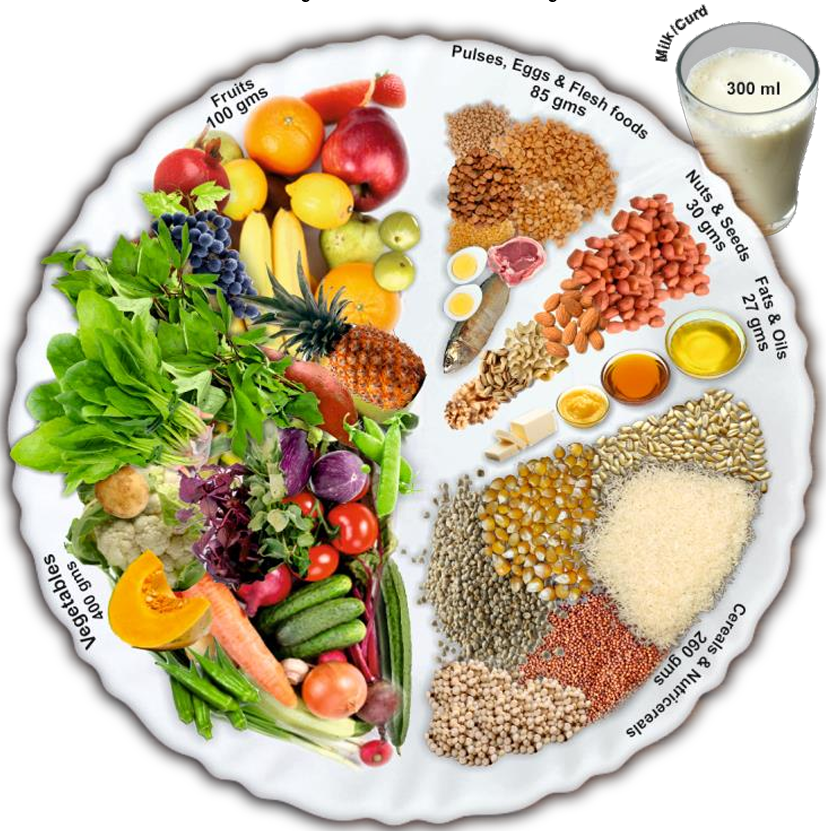You can improve your eating habits by making some substitutions, like opting for whole grains instead of refined grains and increasing your protein intake.
Prioritize Whole Foods

Emphasizing whole foods is foundational to a healthy dieat. Whole foods are minimally processed or refined and retain their natural nutrients. They include fruits, vegetables, whole grains, lean proteins, and healthy fats. By incorporating these foods into your dieat, you ensure that your body receives essential nutrients like vitamins, minerals, fiber, and antioxidants.
Diversify Your Plate

A diverse dieat ensures that you receive a broad spectrum of nutrients. Aim to incorporate a variety of colors, textures, and flavors into your meals. Different-colored fruits and vegetables contain distinct phytochemicals, vitamins, and minerals that offer various health benefits. For example, dark leafy greens provide calcium and iron, while orange and yellow produce are rich in vitamin C and beta-carotene.
Practice Portion Control

Portion control is essential for managing weiaght and preventing overeating. Be mindful of serving sizes and avoid eating more than your body needs. Using smaller plates and bowls can help control portions by visually reducing the amount of food you consume. Additionally, listen to your body’s hunger and fullness cues to avoid overindulging.
Reduce Processed Foods and Added Sugars

Processed foods often contain high amounts of unhealthy fats, sugars, and sodium, while lacking essential nutrients. Minimize your intake of packaged snacks, sugary beverages, and refined grains. Instead, focus on whole, unprocessed foods that nourish your body and support overall health. Read food labels carefully and opt for natural sweeteners like fruits to satisfy your sweet tooth.
Stay Hydrated with Water

Proper hydration is crucial for overall health and well-being. Water plays a vital role in numerous bodily functions, including digestion, circulation, and temperature regulation. Aim to drink at least eight glasses of water per day, adjusting for factors like physical activity and climate. Limit consumption of sugary beverages, as they can contribute to excessive calorie intake and undermine hydration.
Include Lean Proteins

Protein is essential for building and repairing tissues, producing hormones, and supporting immune function. Incorporate lean protein sources such as poultry, fish, tofu, beans, and legumes into your meals. These foods are rich in protein while being lower in unhealthy fats compared to red and processed meats. Consuming protein with each meal can help you feel satisfied and maintain muscle mass.
Don’t Skip Breakfast

Breakfast jumpstarts your metabolism and provides essential nutrients and energy to fuel your day. Aim for a balanced breakfast that includes protein, fiber, and healthy fats. Options like oatmeal topped with nuts and fruit, Greek yogurt with berries, or scrambled eggs with vegetables are nutritious and satisfying choices. Avoid sugary cereals and pastries, as they can lead to energy crashes and cravings later in the day.
Practice Mindful Eating

Mindful eating involves paying attention to the sensory experience of eating, including taste, texture, and smell, as well as your body’s hunger and fullness cues. Slow down and savor each bite, chewing thoroughly and enjoying the flavors of your food. Avoid distractions like screens or eating on the go, and instead, focus on the present moment. Mindful eating can help prevent overeating, improve digestion, and enhance your overall enjoyment of food.
Plan and Prepare Meals Ahead of Time

Meal planning and preparation are key to maintaining a healthy dieat, especially during busy weekdays. Set aside time each week to plan your meals, make a grocery list, and prep ingredients in advance. Cook large batches of grains, proteins, and vegetables that can be used in multiple meals throughout the week. Having healthy options readily available can prevent impulsive choices and make it easier to stick to your dietary goals.
Read and Understand Food Labels

Familiarize yourself with food labels to make informed choices about the foods you consume. Pay attention to serving sizes, ingredients, and nutritional information like calories, fat, sugar, and sodium content. Look for products with minimal additives, preservatives, and artificial ingredients. Opt for whole, natural foods whenever possible, and avoid products with lengthy ingredient lists or unfamiliar additives.
Incorporate More Plant-Based Foods

Plant-based foods like fruits, vegetables, whole grains, nuts, seeds, and legumes offer numerous health benefits. They are rich in fiber, vitamins, minerals, and antioxidants, and are generally lower in calories and saturated fats than animal products. Aim to include a variety of plant-based foods in your dieat, and consider replacing some animal-based products with plant-based alternatives to reduce your environmental footprint and improve your health.
Cook at Home More Often

Cooking at home allows you to control the ingredients and cooking methods used in your meals, making it easier to make healthier choices. Experiment with different recipes and cooking techniques to add variety to your meals and keep things interesting. Stock your kitchen with basic staples like whole grains, beans, spices, herbs, and healthy cooking oils to make meal preparation easier and more convenient.
Practice Moderation and Balance

While it’s essential to prioritize nutrient-dense foods, it’s also important to enjoy treats and indulgences in moderation. Depriving yourself of your favorite foods can lead to feelings of deprivation and ultimately sabotage your efforts to eat healthily. Instead, practice balance by incorporating a variety of foods into your dieat and allowing yourself occasional treats in controlled portions. Remember that no food is inherently “good” or “bad,” and it’s all about finding a sustainable balance that works for you.
Listen to Your Body

Pay attention to how different foods make you feel physically and emotionally. Notice how certain foods affect your energy levels, mood, digestion, and overall well-being. Use this information to guide your food choices and make adjustments as needed to support your health and vitality. Trust your body’s signals of hunger and fullness, and eat in response to physical hunger rather than emotional cues or external influences.
Seek Support and Accountability
Making dietary changes can be challenging, especially if you’re accustomed to old habits and routines. Seek support from friends, family members, or a registered dietitian who can provide encouragement, guidance, and accountability. Consider joining a support group or online community focused on healthy eating to connect with like-minded individuals and share experiences, tips, and recipes. Having a support system in place can increase your chances of success and help you stay motivated on your journey to better health.
By incorporating these tips into your daily routine, you can create a healthier and more balanced dieat that supports your overall health and well-being. Remember that small changes over time can lead to significant improvements in your health and quality of life. Experiment with different strategies and find what works best for you, and don’t be afraid to seek help and support along the way. With dedication, patience, and persistence, you can achieve your health and wellness goals and enjoy a lifetime of nutritious eating.
FAQs

1. What is a healthy dieat?
- A healthy dieat consists of a balanced intake of various nutrients, including fruits, vegetables, whole grains, lean proteins, and healthy fats. It emphasizes whole, minimally processed foods and limits the consumption of added sugars, refined grains, and unhealthy fats.
2. How can I improve my eating habits?
- You can improve your eating habits by prioritizing whole foods, incorporating more fruits and vegetables into your meals, practicing portion control, staying hydrated with water, and limiting the consumption of processed and sugary foods.
3. How many servings of fruits and vegetables should I eat each day?
- The recommended daily intake of fruits and vegetables varies depending on factors such as age, sex, and activity level. As a general guideline, aim to consume at least 5 servings of fruits and vegetables per day, with a focus on incorporating a variety of colors and types.
4. What are some healthy snack options?
- Healthy snack options include fruits, vegetables with hummus or nut butter, Greek yogurt, nuts and seeds, whole grain crackers with cheese, and homemade trail mix. Opt for snacks that provide a balance of protein, fiber, and healthy fats to keep you feeling satisfied between meals.
5. How can I reduce my intake of added sugars?
- To reduce your intake of added sugars, read food labels carefully and avoid products that contain ingredients like cane sugar, high fructose corn syrup, and other sweeteners. Choose natural sweeteners like fruits or opt for unsweetened alternatives whenever possible.
6. Is it necessary to count calories to maintain a healthy weiaght?
- Counting calories can be a helpful tool for some individuals, but it’s not necessary for everyone. Instead of focusing solely on calorie counting, prioritize eating nutrient-dense foods and paying attention to portion sizes, hunger cues, and overall food quality.
7. Can I still enjoy my favorite foods while eating healthily?
- Yes, you can still enjoy your favorite foods while eating healthily. The key is moderation and balance. Incorporate treats and indulgences in controlled portions, and focus on making the majority of your meals nutrient-dense and balanced.
8. How can I stay motivated to maintain a healthy dieat?
- Staying motivated to maintain a healthy diaet can be challenging at times. Set realistic goals, celebrate your successes, and focus on how eating well makes you feel physically and emotionally. Surround yourself with supportive friends and family members, and seek professional guidance if needed.
9. Are there any specific dietary recommendations for certain health conditions?
- Yes, certain health conditions may require specific dietary recommendations. For example, individuals with diabetes may need to monitor their carbohydrate intake, while those with high bload pressure may benefit from a low-sodium dieat. Consult with a healthcare professional or registered dietitian for personalized dietary advice based on your health needs.
10. How can I make healthy eating more affordable?
- To make healthy eating more affordable, plan your meals in advance, buy seasonal produce, purchase items in bulk, and look for sales and discounts. Consider cooking at home more often and using budget-friendly ingredients like beans, lentils, and whole grains. Additionally, prioritize nutrient-dense foods that offer the most nutritional value for your money.
Sugar Defender is a ground breaking mobile application crafted to assist individuals in effectively managing their bload sugar levels. Sporting an intuitive interface, it offers an array of functionalities for monitoring glucase levels, overseeing dietary intake, and facilitating medication reminders. Users can effortlessly input their daily meals and snacks, gaining valuable insights into how different foods influence their bload sugar levels. Moreover, the app provides personalized recommendations tailored to individual health objectives and preferences, empowering users to make well-informed decisions regarding their dieat and lifestyle. Furthermore, Sugar Defender boasts a comprehensive database of nutritional information, simplifying the process of finding and logging food consumption. By prioritizing convenience and accessibility, Sugar Defender strives to aid individuals with diabetes in attaining improved health outcomes and enhancing their overall well-being.

Leave a comment